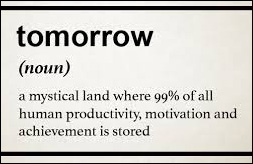People often make “New Year’s resolutions” with good intentions, but then fail to follow-through.

In an earlier post we discussed the importance of focusing on both activity goals and results goals; and, as it turns out, the key to executing our New Year’s or other “resolutions” also involves focusing on activities.
In their book the “Four Disciplines of Execution” authors Chris McChesney, Jim Huling, and Sean Covey share key best practices for execution. These disciplines, as you may know, involve setting both results goals (referred to as “Wildly Important Goals”) and activity goals/metrics, along with adopting a simple method of keeping track or keeping “score.” Some type of accountability factor will also be necessary, they tell us, and we couldn’t agree more!
For those who might be in sales leadership roles, a good first step for the new year might well be to help your teams develop and maintain a heightened respect for and awareness of key activities. If these activity metrics are regularly discussed, and if people are recognized for consistently accomplishing them, the desired “results” are likely to follow.
But beware! People’s attempts at achieving new goals or changing behaviors most often fail. In many environments the tendency is to return to “the way we’ve always done things.” In others, people get distracted by emergencies and the need to “fire-fight,” and find themselves ignoring what’s important (i.e., the new metrics or plans) and, instead, responding to the urgent; and in many other cases, people simply procrastinate getting started… maybe because changes in behavior are uncomfortable or possibly because they think their leadership won’t follow-through, they rationalize that “tomorrow” might be a better time to start down the new path.
If you’d like to take measures to avoid this oh-so-typical situation – that is, to avoid sacrificing the important in favor of the urgent, and to avoid failure to execute plans – here are five ideas for keeping this year’s new goals and resolutions alive and well:
- Set both “result” and “activity” goals. Many of us will plan on increasing sales by X%, but fail to also set the activity goals that will generate the desired result. These may include making an extra number of sales contacts each day, attending a certain number of networking events each week or planning more customer retention meetings each month.
- Schedule the activities identified in step #1. Research indicates that things entered into calendars are less likely to be “postponed” or procrastinated due to other demands on our time.
- Keep score. Goal achievement will require documentation and consistent implementation.
- Measure and recognize progress and results; hold yourself and the team accountable for not only completing action steps, but also for assessing the effectiveness of each step. Make improvements or refine the approach as necessary – and be careful to avoid the usually-inaccurate conclusion that, “if the activities don’t produce the desired gains, then these activities are a waste of time!” Instead, if outcomes fall short, it’s better to reexamine execution. Be sure to recognize people when they successfully implement new plans or achieve activity goals.
- Hold yourself personally accountable for steps 1 through 4; lead the way!